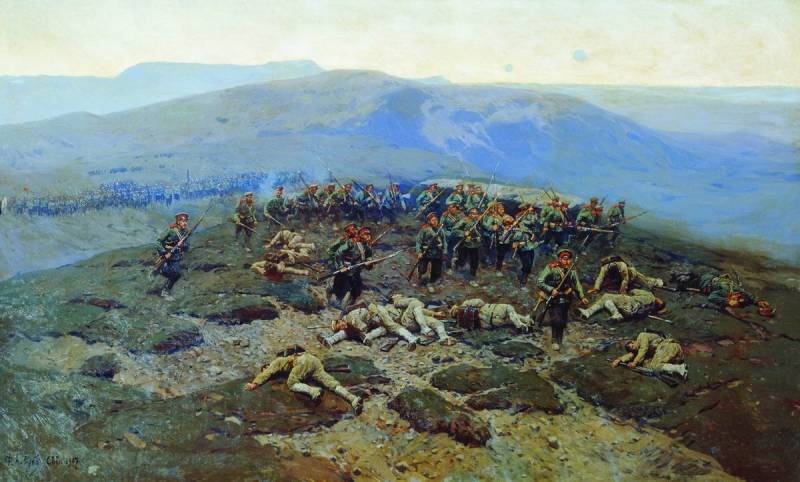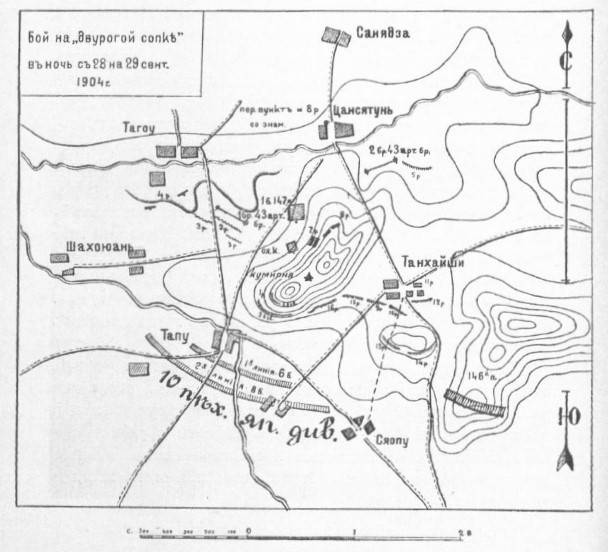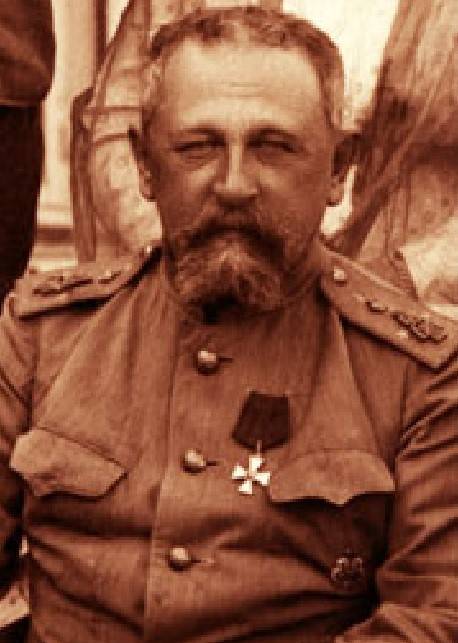The feat of the Novocherkassk Infantry Regiment in 1904

F. A. Rubo. Attack of the Novocherkassk regiment in the battle on the Shakh River. 1904
Every educated person knows the name of Franz Alekseevich Roubaud and at least two of his epic works - the panoramas “The Battle of Borodino” and “The Defense of Sevastopol”. Some battle paintings of this great artist remain little known. One of them, which became a monument to the heroism of the personnel of the 145th Novocherkassk Infantry Regiment, and the very feat of the Novocherkassk residents in the Russo-Japanese War will be discussed.
The painting “Attack of the Novocherkassk regiment in the battle on the Shakh River. 1904" was written in 1907. The canvas, approximately 2,5 x 1,5 meters in size, is exhibited in the building of the Battle of Borodino Panorama Museum. One can imagine what impression the event in question made on the great artist if he chose it as a subject for his painting.
According to Sytin’s “Military Encyclopedia,” during the Russo-Japanese War, the Novocherkassk regiment, arriving at the theater of military operations on August 16, 1904, entered the battle on the Shakhe River. On October 11, the regiment, being in the vanguard of the I Army Corps, took a position on the Two-horned Hill near the village of Tanhaishi and on the night of October 12 was surrounded by the Japanese 10th Infantry Division. Despite the superiority of the enemy forces, the regiment stubbornly held its position until dawn and, having repulsed all night attacks, fought its way to its troops with bayonets, leaving no trophies for the enemy.
The anonymous author of the article in the said “Encyclopedia” made at least two inaccuracies: firstly, there was no environment as such (see diagram below); secondly, there were prisoners on our side who are not mentioned.
This was the first battle of the regiment formed in 1863, therefore in the specified “Encyclopedia” the battle is called a “baptism of fire.”
It is noteworthy that this event received attention on the pages of the Japanese newspaper The Japan Daily Mail (November 29, 1904).
Also, according to the Military Encyclopedia, already on October 13-14, the Novocherkassk regiment as part of the 37th Infantry Division took part in the battle near the village of Yanshuten, where they repulsed three Japanese attacks. In total, in the battles on the Shakhe River, Novocherkassk lost 34 officers and 1 lower ranks.
A detailed description and analysis of the battle on the Shakh River on about a hundred pages of text was carried out by regimental officer Lieutenant I.V. Pobedonostsev in his book “On the Two-horned Hill. Essay on one battle from the Russian-Japanese War" (St. Petersburg, 1908).
It is known about Ivan Vasilyevich Pobedonostsev that he participated in the First World War and on October 12, 1915, with the rank of captain, died of wounds (RGVIA, f. 16196, op. 1, d. 1192, doc. 216).
Staff Captain V. G. von Toll in his book “145th Novocherkassk Infantry Regiment of Emperor Alexander III. 1796–1863–1913. Historical essay" (St. Petersburg, 1914) gave a fascinating description of the battle on the Shakh River (pp. 56–63). In this case, von Toll refers to the aforementioned study by Pobedonostsev. The fate of Voldemar Gustavovich von Tol could not be traced.

Diagram from the named book by V. G. von Tol, p. 60.
During the battle, the Novocherkassk troops were commanded by Colonel N. N. Karepov. Regarding the event being covered, it is known about the regiment commander that Nikolai Nikolaevich Karepov entered in 1877, and in 1879 he graduated from the 2nd Konstantinovsky Military School and was released with the rank of second lieutenant. Having held the rank of colonel since 1899, on August 7, 1904, he was appointed to command the 145th Novocherkassk Infantry Regiment, with which he fought his first battle. For this deed, Colonel Karepov in 1905 was awarded the Order of St. Anne, 2nd degree with swords.
The Novocherkassk regiment and its commander fought just as bravely in February-March 1905 in the Battle of Mukden. On January 3, 1910, for the regiment’s valiant actions during the Russo-Japanese War, it was awarded St. George’s silver trumpets with the inscription “For Distinction in 1904–1905.”
It is known about the further fate of the heroic commander that in 1909 he was awarded the rank of major general. In World War I, as commander of the 1st Brigade of the 40th Infantry Division, he took part in the campaign in East Prussia. From November 1914 he commanded the 30th Infantry Division, becoming a lieutenant general in 1915. After the October Revolution he served in the Red Army, but later in the south of Russia he went over to the side of the White movement. He died in exile in the Serbian city of Kladovo.

Lieutenant General Karepov. The photograph was taken no earlier than April 1916, since the Order of St. George, 4th degree, which is visible on the tunic, was awarded to Lieutenant General Karepov on April 13, 1916.
Notes:
1. Despite the honorary name “Novocherkassk”, the regiment had nothing to do with the Don Cossack Army.
2. All dates are given according to the new style.
3. I.V. Pobedonostsev published another book dedicated to the Novocherkassk Regiment in the Russo-Japanese War - “The Valor of the Russian Warrior: Feats of Courage Shown During the Last War.” (SPb., 1910).
4. Brief bibliography about the life of N. N. Karepov:
– List of senior military commanders, chiefs of staff: districts, corps and divisions and commanders of individual combat units. St. Petersburg, 1913.
– Warsaw-Ivangorod operation. Collection of documents from the world imperialist war on the Russian front (1914–1917). M., 1938.
- Zalessky K. A. Who was who in the First World War. Biographical encyclopedic dictionary. M., 2003.
– Military Order of the Holy Great Martyr and Victorious George. Biobibliographic reference book. M., 2004.
- Egorov N. D. Russian generals on the eve of the Civil War. Materials for the biographical reference book. M., 2004.
- Ismailov E. E. Gold weapon with the inscription "For bravery". Lists of cavaliers 1788–1913. M., 2007.
- Volkov S.V. Generals of the Russian Empire. Encyclopedic dictionary of generals and admirals from Peter I to Nicholas II. T.I.M., 2009.
- Potemkin E. L. Highest officials of the Russian Empire (22.10.1721 – 02.03.1917). Biographical Dictionary. T. II. M., 2019.
Information